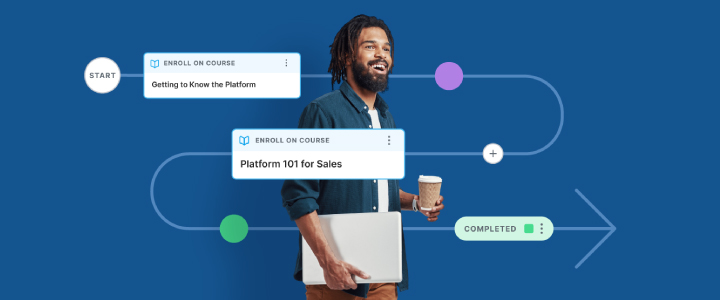
4 min reading time
What is Information Processing Theory?: Using it in Your Corporate Training
Information Processing Theory is a cognitive theory that focuses on how information is encoded into our memory. The theory describes how our brains filter information, from what we’re paying attention to in the present moment, to what gets stored in our short-term or working memory and ultimately into our long-term memory.
The premise of Information Processing Theory is that creating a long-term memory is something that happens in stages; first we perceive something through our sensory memory, which is everything we can see, hear, feel or taste in a given moment; our short-term memory is what we use to remember things for very short periods, like a phone number; and long-term memory is stored permanently in our brains.
History of Information Processing Theory
Developed by American psychologists including George Miller in the 1950s, Information Processing Theory has in recent years compared the human brain to a computer. The ‘input’ is the information we give to the computer – or to our brains – while the CPU is likened to our short-term memory, and the hard-drive is our long-term memory.
Our cognitive processes filter information, deciding what is important enough to ‘save’ from our sensory memory to our short-term memory, and ultimately to encode into our long-term memory. Our cognitive processes include thinking, perception, remembering, recognition, logical reasoning, imagining, problem-solving, our sense of judgment, and planning.
In a corporate training environment, it’s crucial that participants retain the material in the long-term; this post will offer some insight into how to deliver memorable courses.
Information Processing Theory Examples
Creating memories by using different stimuli
Sensory memory is the first stage of Information Processing Theory. It refers to what we are experiencing through our senses at any given moment. This includes what we can see, hear, touch, taste and smell. Sight and hearing are generally thought to be the two most important ones.
In a learning environment, you can engage people by training in a variety of styles that appeal to different senses. For example, you can explain the benefits of a new product orally. This engages people’s ears and is known as echoic memory; show them an infographic that conveys the information visually, which creates iconic memories; and hand around samples of the product so that they can touch it.
When you present information in a variety of different ways, you ensure that you’re appealing to the strengths of everyone in your training session, and increasing the likelihood that they will retain it.
The role of our short-term or working memory
Information is filtered from our sensory memory into our short-term or working memory. From there, we process the information further. Some of the information we hold in our short-term memory is discarded or filtered away once again, and a portion of it is encoded or stored in our long-term memory.
A number of factors impact how we process things in our working memory. These include our individual cognitive abilities, the amount of information we’re being asked to remember, how focused we’re able to be on a given day and how much of our attention we give to the information.
We also have the ability to focus on the information we deem to be most important or relevant. Then we use selective processing to bring our attention to those details in an effort to remember them for the future.
Repetition is a crucial factor here; if we want our trainees to transfer crucial information from their short-term memory into long-term storage, we must repeat it more than once.
Encoding information into long-term memory

Since we filter out information at each stage of processing, trainers should employ certain strategies to ensure your audience understands a topic in-depth. These include:
- Breaking up information into smaller parts: There’s only so much information we can take on board at once, so when you’re training you should move at an appropriate pace, giving your learners plenty of breaks and opportunities to process the information.
- Make it meaningful: Trainees are more likely to retain information that’s meaningful to them by connecting it to real-life scenarios, and to their own personal experiences.
- Connect the dots: To optimize the chances of material being retained in long-term memory, you should ‘layer’ the material, by providing sufficient background information and connecting the current lesson to what was previously learned, and to what will be learned next.
- Repeat, repeat, repeat: One of the simplest ways to encode new facts into long-term memory is to present it more than once. Repeating information in different formats – verbal, written, visual, tactile – is a great way of doing this (you might notice we already made this point in different words above – and we’re repeating it here so that you retain it for the future!)
Limitations of Information Processing Theory
The analogy of the human brain and a computer is somewhat limited. As humans, our ability to learn and retain information is swayed by a variety of influences, from our level of motivation to learn to our emotions – factors that don’t impact computers.
Computers also have a limited capacity in their CPU, while the human capacity for memory is unlimited. And computers process things serially while humans have immense capacity for parallel processing, or digesting multiple pieces of information at once.
Benefit of Information Processing Theory for Organizations
Information Processing Theory is a useful framework for structuring corporate training. It offers you a formula for ensuring that your learners gain more than a passing knowledge of the material we present to them. It helps ensure that it’s encoded into their long-term memory for recall whenever it’s needed.
Check out our recent post on Cognitive Learning Theory, which shares a few similarities with Information Processing Theory, and decide what’s right for your organization.
What strategies do you use to help learners retain the material you’re delivering in the long-run? Leave us a comment and let us know if you’re using Information Processing Theory and if you have any tips for implementing it.



